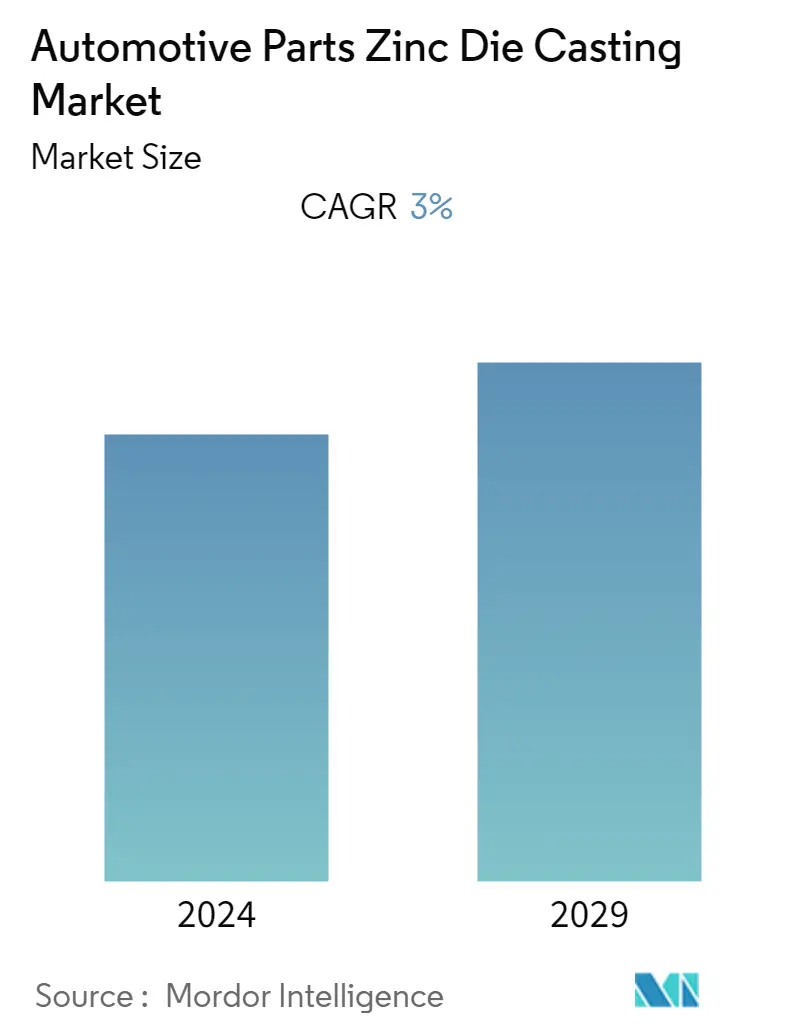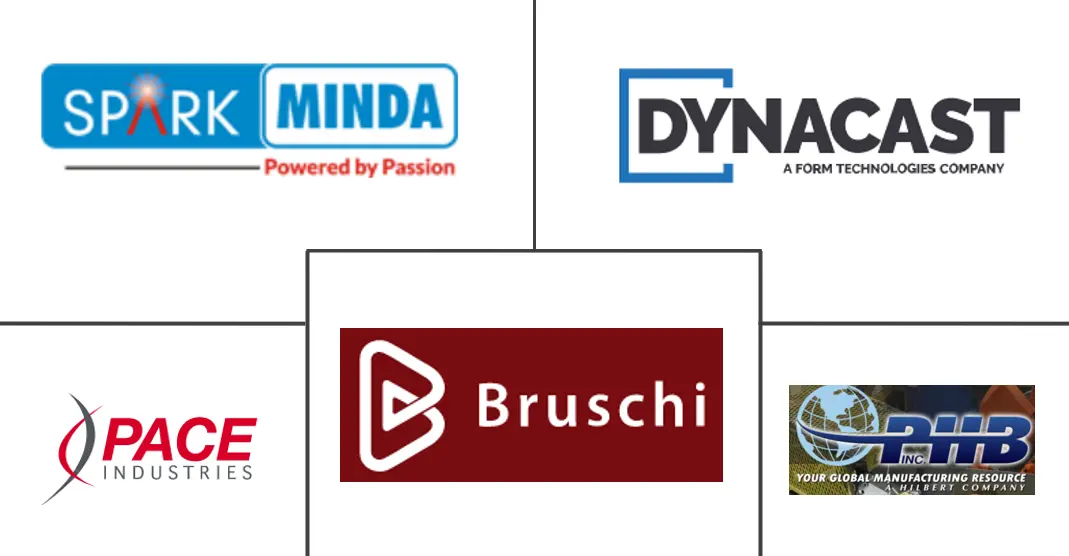Market Size of Automotive Parts Zinc Die Casting Industry

| Study Period | 2019 - 2029 |
| Base Year For Estimation | 2023 |
| CAGR | 3.00 % |
| Fastest Growing Market | Europe |
| Largest Market | Asia-Pacific |
| Market Concentration | Medium |
Major Players
*Disclaimer: Major Players sorted in no particular order |
Automotive Parts Zinc Die Casting Market Analysis
The automotive parts zinc die casting market was valued at USD 3.66 Billion in 2021 and is expected to grow to USD 4.37 Billion by 2027, by registering a CAGR of 3%, during the forecast period.
The COVID-19 pandemic hampered the market in focus for the year 2020, primarily attributed to declined sales and production of vehicles across the world. The global vehicle sale declined by 16% in 2020 as compared to the 2019 vehicle sales. All main vehicle-producing countries had major declines, ranging from 11% to almost 40%. Europe represented an almost 22% share of global production. However, since the second half of the year 2020, the market started witnessing growth due to the start of vehicle manufacturing. for the year 2021, global vehicle sales witnessed a considerable increase when compared to the year 2020.
Over the long term, Lightweight vehicles are gaining popularity among vehicle manufacturers owing to an enhanced fuel economy of automobiles with the adoption of lightweight automotive materials manufacturing crucial parts. Growing consumer trend toward safety products in the vehicle is likely to witness major growth for the market. As, zinc die casting is used to manufacture the vehicle safety component including seat belts and other parts such as brakes, sunroofs, and many others.
In order to reduce automobile emissions and increase fuel efficiency, CAFÉ standards and EPA policies are driving the automakers to reduce the weight of the automobile, by employing lightweight non-ferrous metals. Employing die-cast parts as a weight reduction strategy is a major driver for the automotive segment of the market. Although heavier than aluminum, the lower cost of these parts and higher intricacy allowance make them more suitable in certain applications.
Several vehicle manufacturers focusing on the zinc parts as zinc casted products go directly into the assembly process, as zinc casted products already have better finish which reduce the special finishing process. Zinc die casting parts are usually equipped with better mechanical properties, like toughness, and have better thermal and electrical conductivity as compared to other die casting parts, which is likely to enhance the demand for zinc die casting parts in vehicle.
Automotive Parts Zinc Die Casting Industry Segmentation
Die casting is the process of pouring molten metal into a mold cavity under high pressure to produce a part in a specific shape. Zinc metal is easy to cast as compared to aluminum and magnesium metal. Zinc die casting offers a high level of production efficiency, superior quality, and cost-effectiveness. Zinc die casting is used to manufacture vehicle products such as seat belts, windshield wipers, sunroofs, and chassis. The automotive parts zinc die casting market is segmented by production process type, application type, and geography.
Based on the Production process type, the market is segmented into Pressure Die Casting, Vacuum Die Casting, and Other Production Process Types. Based on the application type, the market is segmented into Body Assemblies, Engine Parts, Transmission Parts, and Other Application Types. Based on Geography, the market is segmented into North America, Europe, Asia-Pacific, and the Rest of the World. For each segment, the market sizing and forecasts have been done on the basis of value (USD Billion).
| Production Process Type | |
| Pressure die casting | |
| Vacuum die casting | |
| Other Production Process Types |
| Application Type | |
| Body Assemblies | |
| Engine Parts | |
| Transmission Parts | |
| Other Application Types |
| Geography | |||||||||
| |||||||||
| |||||||||
| |||||||||
|
Automotive Parts Zinc Die Casting Market Size Summary
The automotive parts zinc die casting market is poised for steady growth, driven by the increasing demand for lightweight vehicles and the adoption of zinc die casting in manufacturing critical automotive components. The market experienced a setback during the COVID-19 pandemic due to a decline in vehicle sales and production, but it has since rebounded as vehicle manufacturing resumed. The trend towards lightweight materials is fueled by the need for improved fuel efficiency and compliance with environmental regulations, such as CAFÉ standards and EPA policies. Zinc die casting is particularly valued for its cost-effectiveness and superior mechanical properties, making it a preferred choice for various automotive applications, including safety components and transmission parts. The vacuum die casting process is dominant in the market, known for producing high-quality, weldable components essential for complex automotive designs.
Regionally, the Asia-Pacific market leads in terms of growth, supported by the expanding industrial sector and increasing demand for zinc die-cast components. India is emerging as a significant player due to its competitive pricing and strong demand. The European market, known for its technological advancements, is focusing on reducing vehicle weight to meet stringent emission targets. The market is characterized by strategic collaborations and technological innovations, with key players like Dynacast, Pace Industries, and Minda Corporation Limited investing in research and development to enhance product offerings. The shift towards electric vehicles, particularly in China and Europe, is expected to further boost the demand for zinc die casting products, as manufacturers seek to optimize vehicle performance and reduce environmental impact.
Automotive Parts Zinc Die Casting Market Size - Table of Contents
-
1. MARKET DYNAMICS
-
1.1 Market Drivers
-
1.2 Market Restraints
-
1.3 Industry Attractiveness - Porter's Five Forces Analysis
-
1.3.1 Threat of New Entrants
-
1.3.2 Bargaining Power of Buyers/Consumers
-
1.3.3 Bargaining Power of Suppliers
-
1.3.4 Threat of Substitute Products
-
1.3.5 Intensity of Competitive Rivalry
-
-
-
2. MARKET SEGMENTATION (Market Size by Value-USD Billion)
-
2.1 Production Process Type
-
2.1.1 Pressure die casting
-
2.1.2 Vacuum die casting
-
2.1.3 Other Production Process Types
-
-
2.2 Application Type
-
2.2.1 Body Assemblies
-
2.2.2 Engine Parts
-
2.2.3 Transmission Parts
-
2.2.4 Other Application Types
-
-
2.3 Geography
-
2.3.1 North America
-
2.3.1.1 United States
-
2.3.1.2 Canada
-
2.3.1.3 Rest of North America
-
-
2.3.2 Europe
-
2.3.2.1 Germany
-
2.3.2.2 United Kingdom
-
2.3.2.3 France
-
2.3.2.4 Italy
-
2.3.2.5 Spain
-
2.3.2.6 Russia
-
2.3.2.7 Rest of Europe
-
-
2.3.3 Asia-Pacific
-
2.3.3.1 China
-
2.3.3.2 India
-
2.3.3.3 Japan
-
2.3.3.4 South Korea
-
2.3.3.5 Rest of Asia-Pacific
-
-
2.3.4 Rest of the World
-
2.3.4.1 South America
-
2.3.4.2 Middle-East and Africa
-
-
-
Automotive Parts Zinc Die Casting Market Size FAQs
What is the current Automotive Parts Zinc Die Casting Market size?
The Automotive Parts Zinc Die Casting Market is projected to register a CAGR of 3% during the forecast period (2024-2029)
Who are the key players in Automotive Parts Zinc Die Casting Market?
Minda Corporation Limited, Dynacast, Pace Industries, Bruschi S.p.A. and PHB Corp. are the major companies operating in the Automotive Parts Zinc Die Casting Market.

